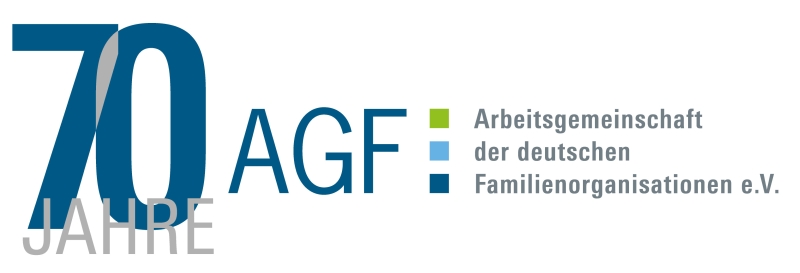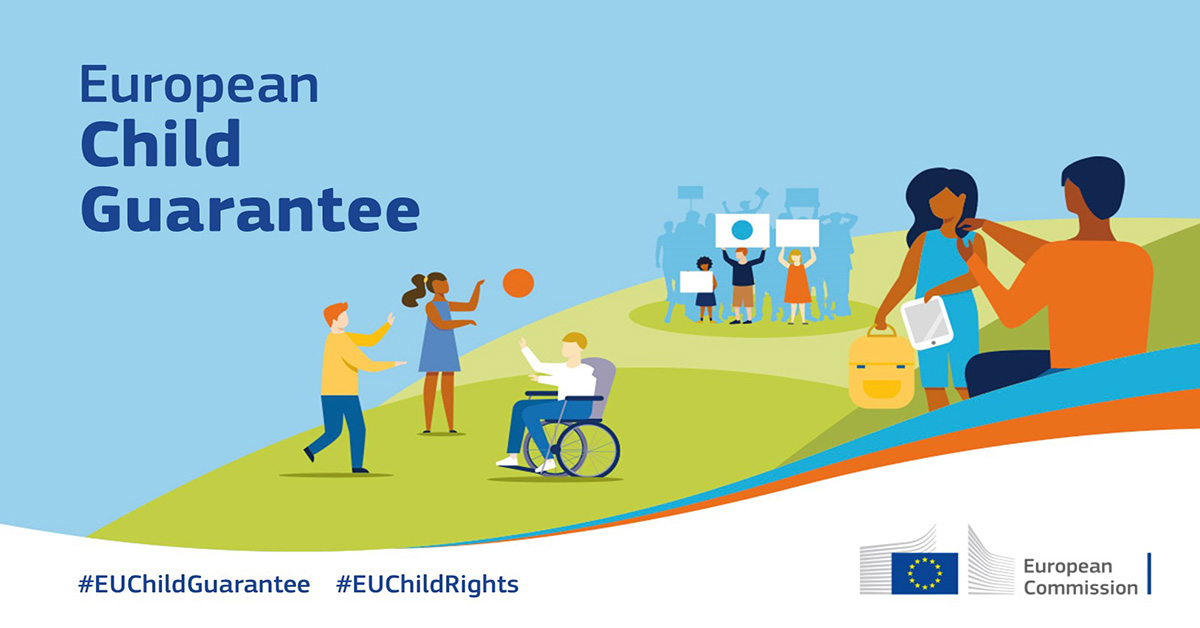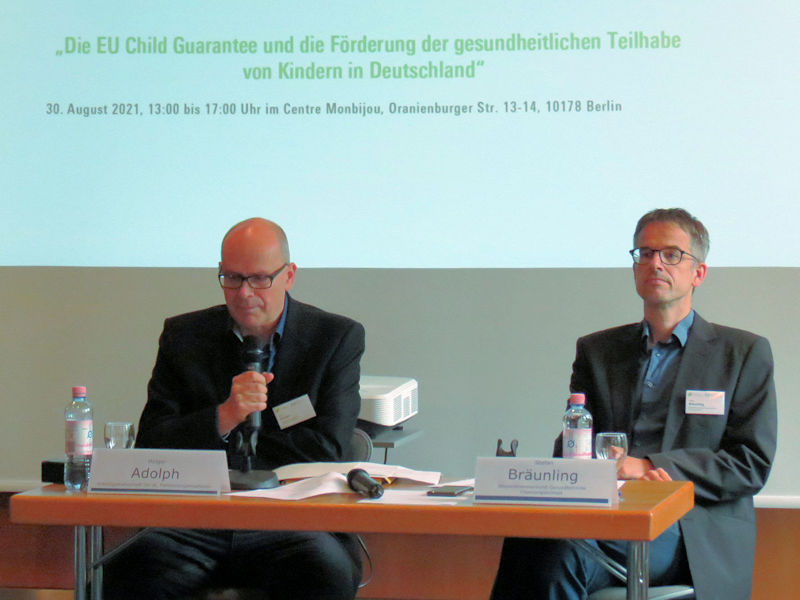
On 30 August 2021, the AGF and the Collaborative Network for Equity in Health (Kooperationsverbund Gesundheitliche Chancengleichheit) jointly held an expert discussion in Berlin on the promotion of children’s access to health initiatives, services or measures, against the background of the “European Child Guarantee”. Twenty-five experts from family associations, children’s rights organisations, science and the field of public health took part.
The Child Guarantee, adopted by EU Member States in June 2021, aims “to prevent and combat social exclusion by guaranteeing access of children in need to a set of key services, thereby also contributing to upholding the rights of the child by combating child poverty and fostering equal opportunities”. Accordingly, the Child Guarantee is embedded in the comprehensive European Strategy on the Rights of the Child, published on 24 March 2021.
“Children in need”, as defined by the Child Guarantee, are children living in or at risk of living in poverty in precarious family situations. However, the Child Guarantee also takes account of other forms of child disadvantage that can impede social inclusion and participation. These include homelessness, disability, migrant background, ethnic discrimination and home education. The Child Guarantee prioritises a number of issues, including improving access to health services, which was the focus of the expert meeting. To this end, the Child Guarantee articulates the following goals: “With a view to guaranteeing effective and free access to quality healthcare for children in need, Member States are recommended to:
(a) facilitate early detection and treatment of diseases and developmental problems, including those related to mental health, ensure access to periodic medical, including dental and ophthalmology, examinations and screening programmes; ensure timely curative and rehabilitative follow-up, including access to medicines, treatments and supports, and access to vaccination programmes;
(b) provide targeted rehabilitation and habilitation services for children with disabilities;
(c) implement accessible health promotion and disease prevention programmes targeting children in need and their families, as well as professionals working with children.”
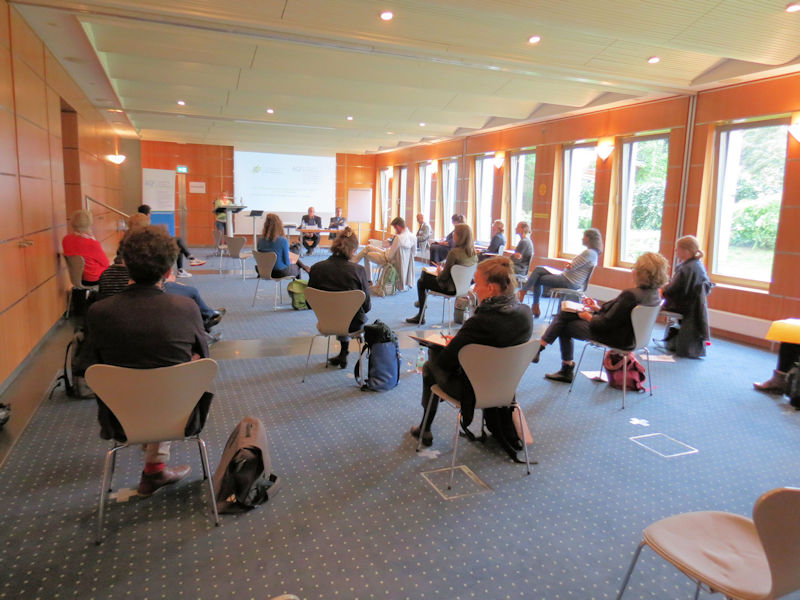
The participants discussed what the Child Guarantee can contribute to improving the health of children at risk of poverty in Germany and how it should be implemented in Germany. The following questions, among others, were raised:
- What is the health status and inclusion in health measures and services of poor children in Germany?
- What framework conditions and support for children and families are needed to ensure access to health services and measures for children in vulnerable situations?
- What measures must be taken in Germany under the Child Guarantee to ensure that this EU initiative leads to an improvement in the health of children?
Four presentations were the catalysts for discussion.
The Child Guarantee and new opportunities for children in Germany
Dr. Martina Kottmann, Head of the Department responsible for the Child Guarantee at the Federal Ministry for Family Affairs, Senior Citizens, Women and Youth (BMFSFJ), first explained the key recommendations of the European Child Guarantee and the Ministry’s current plans for its implementation. She explained that the “European Guarantee for Children” had been warmly welcomed by the Federal Government and that the BMFSFJ had already worked towards its adoption during the German EU Council Presidency in the second half of 2020. At the end of the Council Presidency, the Federal Government had initiated a declaration in support of the Child Guarantee, which almost all Member States had joined.

Both the health objectives and the recommendations / voluntary commitments in the areas of early childhood care, education and upbringing, healthy nutrition and adequate housing were shared by the Federal Government. The Federal Government also supports the focus on special target groups.
With regard to the practical implementation in Germany, she emphasised that the Ministry was currently working intensively on a working structure for implementation. Within nine months, i.e. by March 2022, each Member State is to draw up a national action plan – a “core piece” for the implementation of the Child Guarantee – and appoint a national contact person. The action plan will be valid until 2030, for which a biennial progress report is mandatory. Under the circumstances, with the current legislative period coming to an end and a new government having to be formed after the elections, it is difficult at present to define the main points of focus. The aim is to build up an effective and efficient working structure in which the desired goals can be achieved with cross-thematic and cross-departmental working groups in which external stakeholders are also to be involved. To this end, a coordinator should be appointed who can represent the impulses of the Child Guarantee in the political arena.
However, it is clear that the German action plan should rest primarily on two pillars: first, the strengthening of families and, second, the corresponding infrastructure. Dr. Kottmann named some of the existing activities of the BMFSFJ that fell within the framework of the Child Guarantee: family midwives, expansion of daycare, all-day care, family education, National centres for early intervention and the focus on equal opportunities.
In the discussion, it was stressed that implementation was particularly about organising interdepartmental cooperation in order to prevent fragmentation of the process. This included involving children and young people in the process. In addition, the Länder and municipal levels were relevant in Germany, particularly with regard to educational issues, and must therefore also be appropriately involved. Furthermore, it was noted that there are already approaches in the area of healthcare from which much can be learned and which should be referred to, for example the network “Healthy into life” (Gesund ins Leben) and the “health goal” “Growing up healthy: life skills, exercise, nutrition”. In addition, it was emphasised that a broad concept of health should be applied, which places poverty-related burdens front and centre.
Health inequalities in early life: Health and health service utilisation by children from socially disadvantaged families in Germany
Dr. Julia Waldhauer and Petra Rattay, Robert Koch Institute
Dr. Waldhauer used data from official statistics and results from the study on the health of children and adolescents in Germany (KiGGS wave 2) to illustrate the connections between social and health inequalities in Germany. The data showed that the majority of children and adolescents in Germany grow up healthy. However, already in the early years of life there are pronounced health differences that disproportionately adversely affect children and adolescents from socially disadvantaged families. Since socially conditioned health differences are not confined to acute situations in early life but continue into middle and old age, they represent a great challenge for health promotion, healthcare and society as a whole.
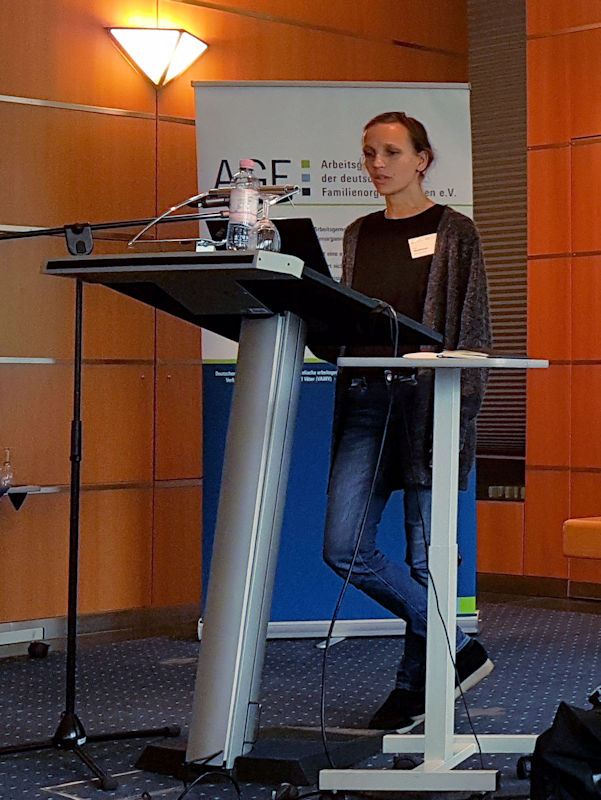
Ms. Waldhauer explicitly described the effects of poverty on the health of children and adolescents, as well as on their material circumstances, their opportunities for social participation and their access to culture. The interactions between these individual burdens are decisive. Compared to their peers from households without financial burdens, children and adolescents at risk of poverty and those already living in poverty (in 2019, about one-fifth of all adolescents in Germany) have higher risks of poorer general health, more frequent mental health problems and greater propensity to obesity. For example, they participate less often in club sports, consume sugary drinks more frequently and make less use of health services. It is important not to use the findings on individual health behaviour in a derogatory way against the children and young people concerned or their parents, but to ask about the constraints and pressures that underlie risky health behaviour. There is a very fine line between identifying inequalities and stigmatizing those affected.
It has been observed that the COVID-19 pandemic and measures to contain it have widened social and health inequalities.
In the discussion, questions were asked about the robustness of the results. Dr. Waldhauer pointed out that the findings on the relationship between socioeconomic and health status were very robust and were also confirmed by many international studies.The audience remarked that the connection between poverty and health is still neglected in political discourse and therefore it is crucial that the Child Guarantee focus explicitly on the context of “poverty”. In the national action plan to be formulated, it was imperative that this be strongly emphasised. However, if targeted measures are to be developed, the complex connection between poverty, education and health must also be considered in a differentiated way, as well as the fact that people with a migration background and single parents in Germany are at particularly high risk of poverty.
Health in All Policies (HiAP) in children, adolescents and families
Prof. Dr. Raimund Geene, Berlin School of Public Health
Prof. Dr. Geene presented the Health in All Policies approach (HiAP) as a strategy for improving the (health-related) living conditions of children and adolescents. Policy measures based on a fragmented and oversimplified concept of health cannot respond to the complex interactions of the social situation, public goods and the health of the population. Using examples of several successful political processes for implementing HiAP, he elaborated on the basic requirements of a health-promoting policy, which should also be taken into account in the Child Guarantee. He presented the well-evaluated HiAP models of the Australian state of South Australia and the so-called “Marmot Cities” in Great Britain, both of which were concerned with the reduction of health inequalities and the fairer distribution of social resources for health.
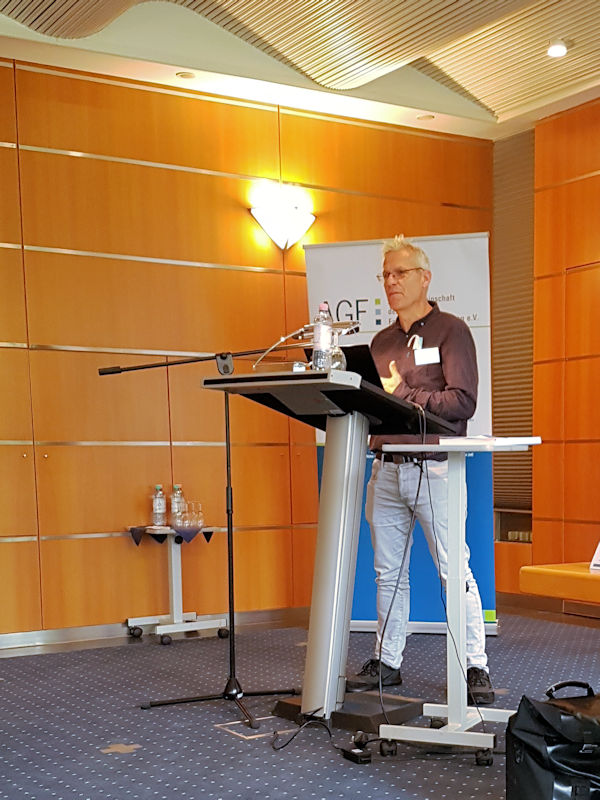
The examples yield some basic requirements for the successful implementation of the objectives of the Child Guarantee. First, an initiative to improve children’s health opportunities and combat poverty must pursue a dual strategy that links government and political activities (“whole-of-government”) with social initiatives (“whole-of-society”). This would have to be accompanied by the creation of exchange and cooperation platforms that enable the extensive participation of the target groups and their families, as well as civil society approaches. On the other hand, better interministerial cooperation with interministerial and multidisciplinary steering groups, as well as joint cross-sectoral budgets for these goals, are urgently needed to achieve political implementation. Furthermore, there is a need for coordinated development of the provision of specialists for health promotion among families/children. Deficits in the availability of small-scale data capable of guiding action would have to be reduced locally in each case.
Overall, this is a sensitive area requiring a balanced approach to the contradiction between support and social control.
On methodology, Geene referred to the German Child Welfare Organisation 2019 Children’s Rights Index, an indicator-based inventory and legal analysis of children’s rights in the German states.
In the discussion, the need to improve the provision of data for small-scale planning and evaluation of health promotion measures was emphasised.
There was debate about whether the Child Guarantee would open a “window of opportunities” for a fundamental improvement of the health of children from poor families or families at risk of poverty. Processes such as the development of the health goal “Growing up healthy” had also raised high expectations. The high demands formulated for a new interministerial and political–civil society culture of cooperation could only be achieved with greater political will to shape things after the Bundestag elections.
Care for children and adolescents in the early intervention system
Dr. Johanna Löchner, German Youth Institute (DJI)
Dr. Löchner focused on two aspects. On the one hand, she used current studies to examine the stresses that occur within partnerships/families when children are born and identified risk factors for psychosocial, health and developmental problems in children over the course of their lives. She referred to the prevalence study sequence “KID 0-3” of the DJI (main study 2015, next study phase 2022). On the other hand, she described the special features of early intervention services, their use by parents and the effects of the interventions.
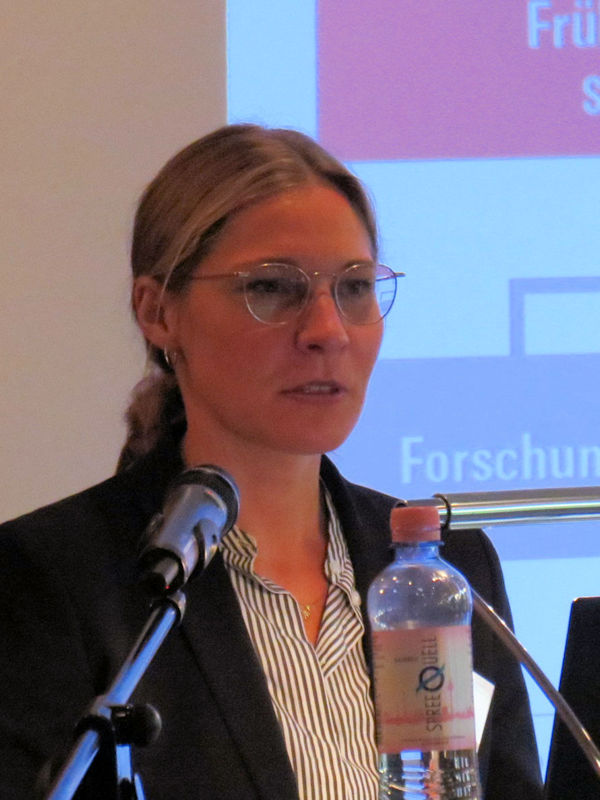
She pointed out that the transition to parenthood was a major challenge for all parents. However, not all parents are stressed to the same extent by the need to adjust to the challenge. Where high levels of stress occurred, however, these were significant risk factors for psychosocial, health and developmental problems in children later in life. Important risk factors for mental health problems in children and adolescents include poverty and educational disadvantage, parental separation, parental conflict, domestic violence, parental mental illness and child disability. However, it is not primarily the occurrence of individual risk factors but their accumulation that impairs child development into adulthood. Protective factors for child development include education, as well as a sound financial situation in the family and sensitive parental care.
The early intervention centre focuses on universal and selective prevention for infants and young children, on the early detection of family stress and risks to the child’s well-being and on early support for parents to enhance their parenting skills. This thus formed an area of work at the interface of health care, youth welfare, pregnancy counselling, early intervention and prevention of the consequences of poverty.
Dr Löchner reported a high level of use of universal prevention programmes across all groups. The universal offers of the early intervention centre reached families regardless of their particular type of stress. The use of target group-specific selective services is particularly high among families with multiple stresses. However, families with increased parental stress and conflict potential do not make use of the selective services of early prevention to the extent expected. This group is also less likely to receive a programme of home visits. Despite a high level of knowledge about selective prevention services, they make less use of these services than socioeconomically and multiply stressed families. This raises the question of whether families with increased parental stress and conflict potential receive too little support because they have no clearly recognisable (material) need for help.
In the discussion, the importance of research in the field of early childhood stress and the effectiveness of early intervention measures was emphasised for the identification of priority needs for action and for the (further) development of supportive interventions. The shortage of specialists restricts not only the care of families under stress but also the possibilities for undertaking participatory research.
It was also noted that so-called multi-problem families often have negative experiences with welfare state support services, which are projected onto early prevention services. Positive learning experiences and well-trained, sensitive professionals are extremely important here.
Final discussion and conclusion
In the concluding discussion, it was stated that the Child Guarantee basically aims to counter important deficits in access to health services of poor children and children at risk of poverty, as well as children who are affected by exclusion for other reasons. The health-related goals of the Child Guarantee are evidently far from being realised in Germany. And this was the case although the measures proposed by the European Council to improve the living conditions of children had already, to a large extent, been formally implemented in Germany.
The focus of the Child Guarantee on reducing the participation deficits of disadvantaged children was assessed differently. Improving their opportunities for access to and sharing in public goods and services is an important project that can bring about lasting changes in the living situations of those affected. On the other hand, in addition to the goal of mitigating the effects of poverty, the actual fight against poverty should not be forgotten. In the context of the implementation of the Child Guarantee, the causes of child poverty and educational poverty had to be fundamentally dealt with. Child poverty is, among other things, a consequence of family poverty. Poverty and wealth reporting shows that, especially after the separation of parents, there is a significantly increased risk for mothers and children of living in poverty or in social situations close to poverty.
However, it is important to identify other groups of children who are excluded from access to health provision and to develop measures for them. In addition to the groups mentioned in the Child Guarantee, such as children in homelessness, with disabilities, with a migration background, from ethnic minorities or living in institutions, these are also, for example, children involved in procedures for granting asylum or with uncertain residence status, trans children and others.
In order to deploy help systems to reduce the negative experiences of disadvantaged children/families, it is also necessary to sensitise the relevant (health) professional actors to their own poverty-discriminatory behaviour. Greater attention must be paid in the training of the relevant professional groups to promoting the ability to adopt appropriate perspectives and resource-oriented attitudes.
Overall, in the process of implementing the health-related goals of the Child Guarantee in Germany, care must be taken to ensure that a broad concept of health in the sense of the Ottawa Charter is taken as a basis. Within government, it is important that there are interdepartmental structures characterised by cooperative thinking and action and with their own budgets for improving the health status of the target groups. Constructive cooperation between federal, state and municipal structures is also necessary.
In addition to government action, it is crucial that civil society actors and associations, as well as affected children and their families, participate in the process of developing policies.
